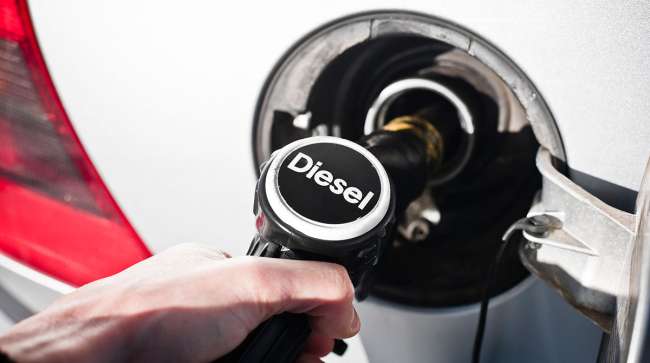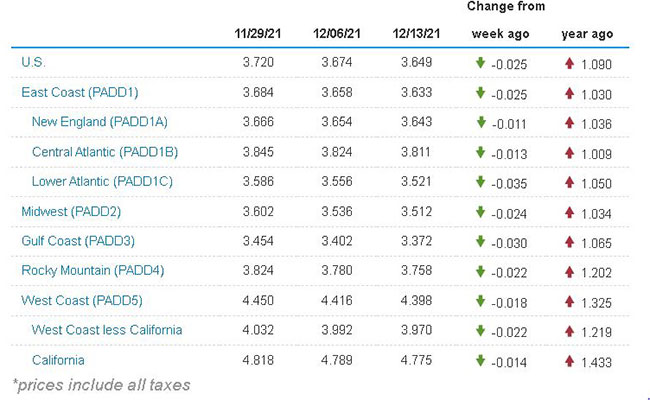Another 2.5¢ a Gallon Lopped Off National Diesel Price

[Stay on top of transportation news: Get TTNews in your inbox.]
The national average price for diesel dipped 2.5 cents to $3.649 a gallon, according to Energy Information Administration data released Dec. 13.
The cost of diesel has declined four consecutive weeks, totaling 8.5 cents, after reaching its 2021 high of $3.734 a gallon Nov. 15.
A gallon of diesel now costs $1.09 more than it did at this time in 2020.
U.S. On-Highway Diesel Fuel Prices

EIA.gov
The price of trucking’s main fuel dropped in all 10 regions in EIA’s weekly survey, with the largest being 3.5 cents in the Lower Atlantic.
The national average price of gasoline slid 2.6 cents to settle at $3.315 a gallon, a drop of 6.5 cents since Nov. 29.
Oil Price Information Service founder and industry analyst Tom Kloza told Transport Topics he is not surprised that the price of oil, gasoline, diesel fuel and other petroleum products is dropping as demand falls. However, he said the decline has been slow because overall oil demand has been light. Two reasons: Much of the country has experienced warmer than expected weather, and driving is down as more people work from home due to rising COVID-19 cases.
“The rate that [prices] are dropping is like continental drift,” Kloza said. “There are a lot of people off for the holiday season and we have been seeing steady drops, but it’s like a quarter of a cent a gallon at the retail level. We’re feathering down, but it’s a delayed reaction.”

Kloza
Kloza said the warmer weather across the Rocky Mountain region, Midwest and South is affecting fuel prices.
“Part of it is that everyone had baked in an extremely cold winter, a lot of analysts were predicting a new ice age,” he said. “It’s certainly not been the apocalyptic ice age situation a lot of the traders had built in.”
Home heating oil, which is used extensively in the Northeast and Midwest, is from a molecular standpoint essentially the same fuel as diesel. So when home heating oil demand increases, diesel prices in those regions also typically increase, Kloza said.
Kloza is optimistic about fuel prices continuing to drop for the next several weeks and through the winter. He sees prices rising in 2022, not because of fuel availability but rather a shortage of worldwide capacity to take the oil and refine it.
“We just don’t have the refining capacity in North America, the U.S., Canada, Caribbean, South America and Europe,” Kloza said. “2022 is kind of an interval year, but at the end of the year we start to get huge, new refineries on line in Nigeria, the Middle East and in the Asian-Pacific region. But it’s going to be a tough year in 2022.”
U.S. average retail prices on December 13:
Regular-grade #gasoline: $3.315
On-highway #diesel: $3.649https://t.co/EWtM1xipg0 pic.twitter.com/6KhxsM8gji — EIA (@EIAgov) December 14, 2021
He said he could see fuel usage dropping again if the omicron variant slows the economy and people return to spending more time at home
“The only way I see prices falling in 2022, and this is not something we want to wish for, is if COVID cuts mobility again with omicron,” he said.
In its December Short-Term Energy Outlook report, EIA said the energy situation “remains subject to heightened levels of uncertainty related to the ongoing recovery from the COVID-19 pandemic, notably, the emergency of the SARS-CoV-2 omicron variant.”
EIA also said worldwide petroleum usage in November increased to 99.7 million barrels per day, compared with 94.8 million during the same month in 2020. However, that latest estimate still is 1.1 million barrels per day less than what was used by consumers and businesses in 2019.
The EIA report said global usage for the year will average 96.9 million barrels per day, an increase of 5.1 million barrels when measured against 2020.
As for gasoline prices, EIA said it is expected they will continue to drop from the nationwide average of $3.39 a gallon in November to $3.01 in January and then dipping even further to $2.88 a gallon on average later in 2022.
Meanwhile, North American oil production continues to soar when measured against year-ago levels and the depths of the industry shutdown during the pandemic. According to the Baker-Hughes rig count, 576 rigs were in operation last week, up seven from the previous week and an increase of 238 from the same week in 2020.
Baker Hughes, based in Houston, ranks No. 66 on the Transport Topics Top 100 list of the largest private carriers in North America.
Canadian oil industry production also is notching up. Canadian producers were operating 177 rigs last week, and that was down three from the previous week, but an increase of 66 from the same time a year ago.
Want more news? Listen to today's daily briefing below or go here for more info:


